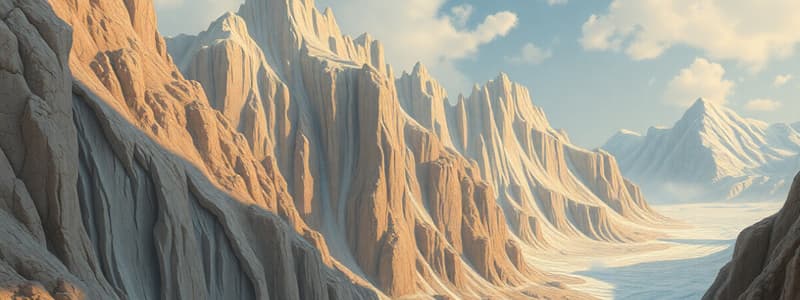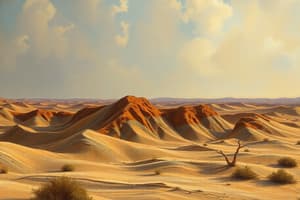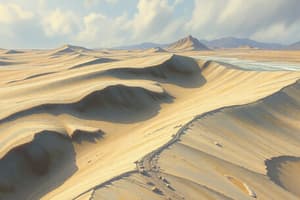Podcast
Questions and Answers
What is formed when glaciers carve steep, pyramid-shaped peaks around a mountaintop?
What is formed when glaciers carve steep, pyramid-shaped peaks around a mountaintop?
- Cirque
- Horn (correct)
- Kettle Lake
- Drumlin
What are the unsorted ridges of till deposited by glaciers called?
What are the unsorted ridges of till deposited by glaciers called?
- Moraines (correct)
- Drumlins
- Outwash
- Kames
How are kettle lakes formed?
How are kettle lakes formed?
- By the convergence of valley glaciers
- From the accumulation of sediment at glacier edges
- From erosion by flowing meltwater
- By the melting of ice blocks from glaciers (correct)
What do we call the area where meltwater flows from a glacier and deposits layered sediment?
What do we call the area where meltwater flows from a glacier and deposits layered sediment?
Which landform is created when continental glaciers move over older moraines?
Which landform is created when continental glaciers move over older moraines?
What is the process called when wind removes surface particles, leading to a lowering of the land surface?
What is the process called when wind removes surface particles, leading to a lowering of the land surface?
Which type of glacier forms in valleys in high mountainous areas?
Which type of glacier forms in valleys in high mountainous areas?
What are rocks shaped by windblown sediments called?
What are rocks shaped by windblown sediments called?
What primarily causes the migration of sand dunes?
What primarily causes the migration of sand dunes?
What forms in locations where more snow falls than melts, evaporates, or sublimates?
What forms in locations where more snow falls than melts, evaporates, or sublimates?
Which glaciers are considered the most powerful erosional agents?
Which glaciers are considered the most powerful erosional agents?
What happens to glaciers when melting exceeds the accumulation of snow?
What happens to glaciers when melting exceeds the accumulation of snow?
Where are continental glaciers primarily found?
Where are continental glaciers primarily found?
Flashcards
Deflation
Deflation
A process where wind removes surface particles, lowering the land surface.
Wind Abrasion
Wind Abrasion
The wearing down of rocks and other materials by windblown particles, like sand.
Ventifacts
Ventifacts
Rocks shaped by windblown sediments.
Glacier
Glacier
Signup and view all the flashcards
Valley Glaciers
Valley Glaciers
Signup and view all the flashcards
Continental Glaciers
Continental Glaciers
Signup and view all the flashcards
Zone of Accumulation
Zone of Accumulation
Signup and view all the flashcards
Plucking
Plucking
Signup and view all the flashcards
Cirques
Cirques
Signup and view all the flashcards
Horns
Horns
Signup and view all the flashcards
Hanging valleys
Hanging valleys
Signup and view all the flashcards
Moraines
Moraines
Signup and view all the flashcards
Outwash
Outwash
Signup and view all the flashcards
Study Notes
Wind Erosion
- Limited precipitation increases wind erosion because precipitation holds down sediments allowing plants to grow.
- Wind transport and erosion mostly happen in areas with little vegetation like deserts, semi-arid areas, seashores, and some lakeshores.
Deflation
- Deflation lowers land surfaces as the wind removes surface particles.
- The Dust Bowl region was created through deflation.
Abrasion
- Abrasion occurs when particles (like sand) rub against rocks and other materials.
- Wind abrasion is a powerful erosion force, wearing away rocks.
- Rocks shaped by windblown sediments are called ventifacts.
Wind Deposition
- Sand particles accumulate in windblown environments where objects (like rocks) block their movement.
- Dunes are piles of windblown sand.
- Dune migration happens when prevailing winds move sand from the windward side to the leeward side, causing the dune to slowly shift.
Glaciers
- A glacier is a large mass of moving ice.
- Glaciers form near Earth's poles and in high-elevation mountainous areas; they cover about 10% of Earth's surface.
- Valley glaciers form in valleys and carve V-shaped stream valleys into U-shaped glacial valleys.
- Continental glaciers cover broad, continent-sized areas. They are currently only found in Greenland and Antarctica.
Glacier Size
- Both valley and continental glaciers grow when snow accumulation exceeds melting, evaporation, or sublimation.
- Valley glaciers' accumulation zones are at mountain tops. Continental glaciers' accumulation zones are at the center of the ice sheet.
- Glaciers recede when melting exceeds accumulation.
Glacial Erosion
- Glaciers are the most powerful erosional agents due to their size and weight.
- Plucking is a process where valley glaciers break off pieces of rock as they move.
- Cirques are bowl-shaped depressions formed by valley glaciers at high elevations where snow accumulates.
- Horns are steep, pyramid-shaped peaks formed when glaciers carve around three or more sides of a mountain.
- Hanging valleys are formed when a higher glacier converges with a lower glacier and retreats, leaving the valley high above the primary valley floor.
Glacial Deposition
- Moraines are unsorted ridges of gravel, sand, and fine-silt sediment deposited by retreating glaciers.
- Outwash is gravel, sand, and fine silt carried by meltwater away from the glacier.
- Outwash plains are areas where meltwater deposits outwash at the leading edge of a glacier.
- Kettle lakes form when meltwater fills holes left by large chunks of ice that break off and melt.
Additional Glacial Deposition Features
- Drumlins are elongated landforms created by continental glaciers moving over pre-existing moraines.
- Eskers are winding ridges of layered sediments deposited by streams flowing under melting glaciers.
- Kames are mounds of layered sediments deposited when meltwater washes sediment into depressions or openings in the melting ice.
Studying That Suits You
Use AI to generate personalized quizzes and flashcards to suit your learning preferences.




